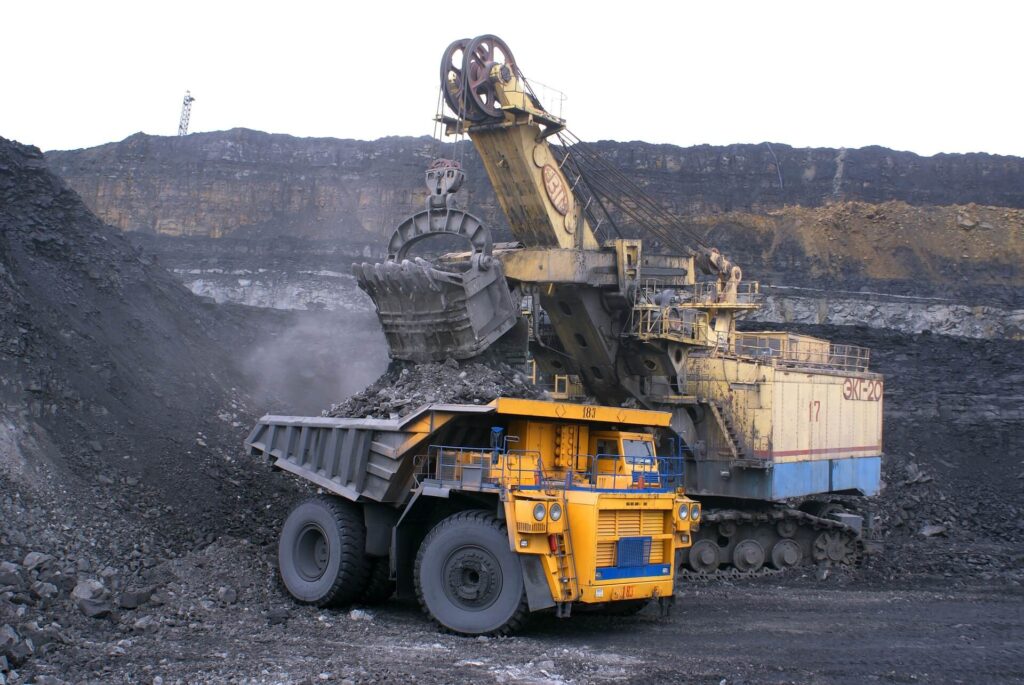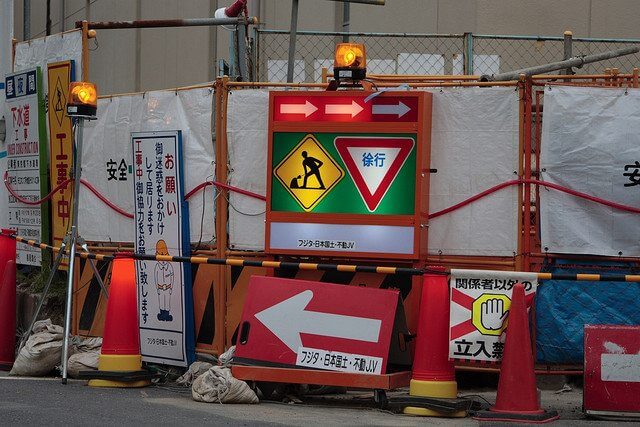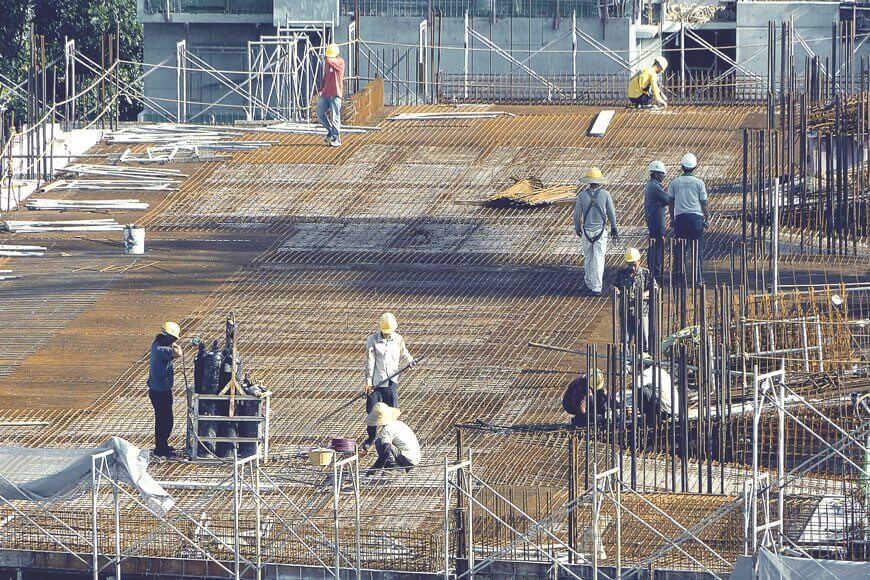The last few years have been a period of huge transformation for the construction industry. The transition to a more efficient and highly digitised era has begun. Nevertheless, there are still many things that need to be done before we can confidently say that the building sector has changed for good. One of those revolves around data in Construction.
In this day and age, “the world’s most valuable resource is no longer oil, but data”. Tech giants like Google, Apple and Facebook have managed to acquire incredible power by controlling the data. It’s indicative that Facebook and Google are responsible for almost all the revenue growth in digital advertising of the United States for 2016.
The data economy has already emerged and it is based on a digital surveillance system: Google can monitor what people are looking for, Amazon can track what they buy and Facebook what content they consider worth-sharing. Based on this information, they can shape their long-term strategy and keep users engaged to their services. That’s why, a big fight on who will take control over the data has already began and it’s expected to become more and more intense. According to IDC, by 2025 the total amount of generated data will be over 180 zettabytes!
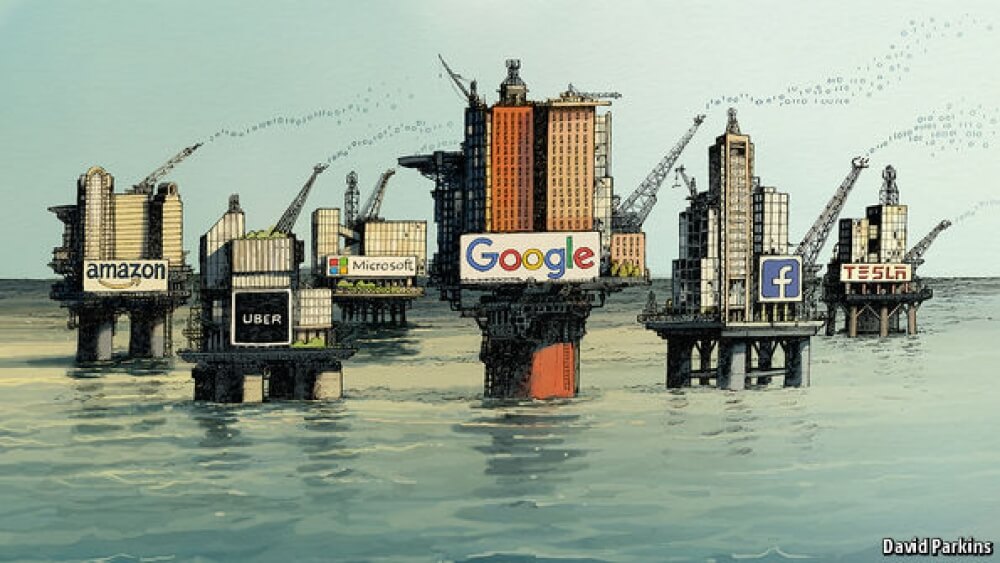
Now, bringing this all back to Construction, Construction as an industry produces the highest amount of data compared to any other industry, but they throw away 95% of it. The building sector is bleeding data and this harms the industry both in terms of productivity and efficiency.
[clickToTweet tweet=”Construction produces the most data than any other industry, but they throw away 95% of it! ” quote=”Construction produces the most data than any other industry, but they throw away 95% of it! “]
Like oil, data is extremely valuable to those who own it. So in this article we will delve into more detail about what we mean when we say data and how you can use it to establish a more profitable, transparent and accountable construction project management process.
“Digital data means more efficient”
In his recent keynote speech at BIMobject LIVE 2017 in Malmö Sweden, Stefan Larsson, CEO of BIMobject, referred to the imminent need for more humanless processes within the construction industry. More specifically, he mentioned the following:
“Everything will be digital. Every process that in our world can be done by a computer will be done by a computer. It will happen unfortunately. Or fortunately. An algorithm or a software is always much more effective than a human. You can scale everything, you can measure it and be aware of what’s happening”.
It becomes clear that information is the center of attention. This is the key to getting every single task done. It increases your knowledge about a product or material, while at the same time it establishes trust and the sentiment of security between the numerous project agents. For that reason, Stefan Larsson believes that change can arrive only through the rationalisation of the building sector and the effort to make everything digital.
The construction industry is in danger
At the moment, construction is battling against some very specific and serious bottlenecks. The increased perplexity of construction projects has raised the bar on performance both for the employees and the industry. In a nutshell, these are the main points of concern for construction:
Productivity struggles
The construction industry is facing serious productivity challenges. Regardless of all the effort and money ($10trn dollar industry) put in the sector, the productivity rate appears to remain flat for at least two decades now. If we make the comparison to the manufacturing industry, the results are even more disheartening. As it is shown on the graph below, productivity in manufacturing has almost doubled, while in construction it has remained the same.
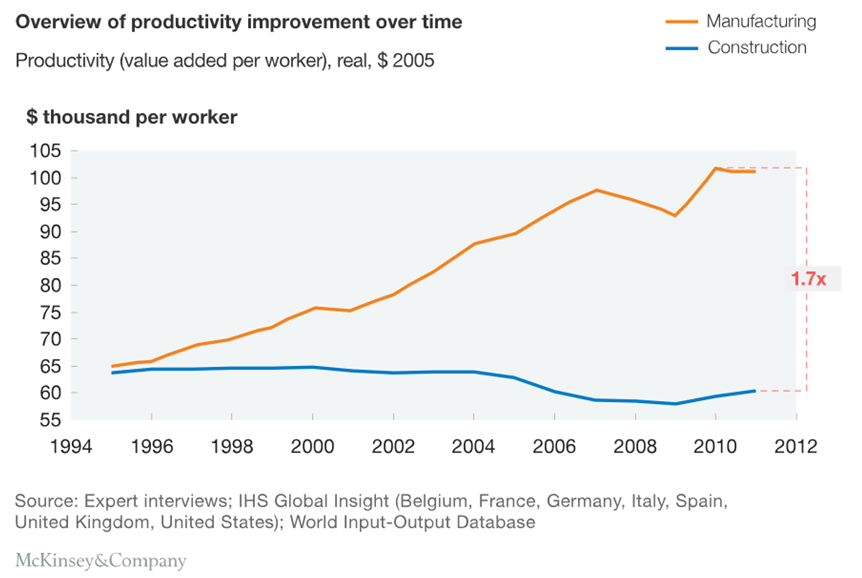
And that’s not all! The construction industry is probably the only industry where labor productivity has declined since 1968. To the contrary, a rising tendency is observed to the majority of the other sectors. The following graph from the US market is more than enlightening for the current state of the industry:
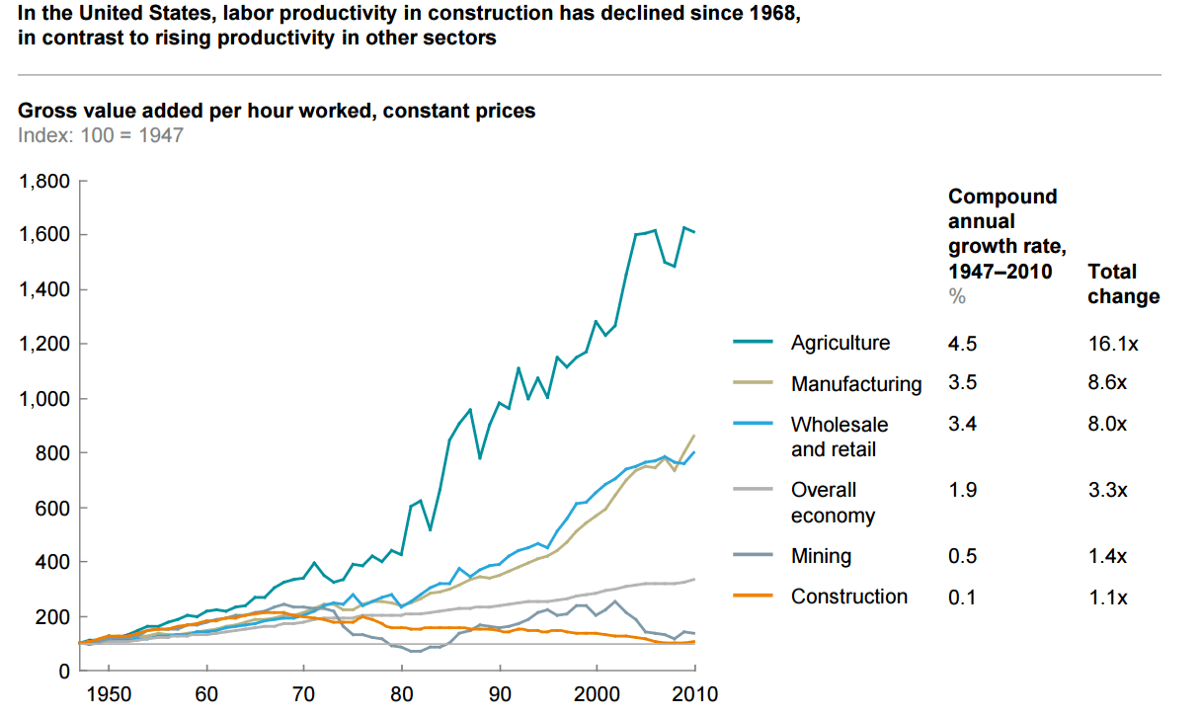
If we take into account that construction is representing 9% of the total EU GDP, it’s easy to realise that the building sector has to change and learn to take better care of its data.
Data fragmentation
Construction agents need to become better in collecting, administering and eventually comprehending the available data. And that will come through the investment in digital tools and the active support to automated processes. Unfortunately, the construction industry hasn’t done a great job toward that direction so far. According to McKinsey’s digitisation index, only agriculture is performing worse than construction in terms of digitisation.
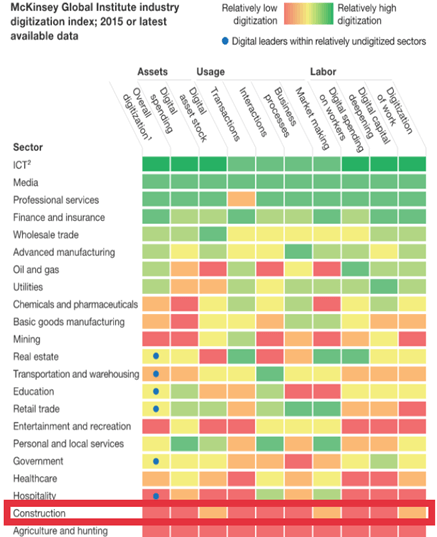
The graph speaks for itself and emphatically demonstrates that the industry has to change. Otherwise, construction will keep throwing valuable data out of the window. As stated by Klaus Nyengaard, GenieBelt Chairman, 95% of all generated data are discarded or not collected at all.
Behemoth waste rates
Waste rates are also hurting construction. Stefan Larsson highlights that only in Europe, we generate on average 830 millions of construction waste yearly. This is the result of poor planning and collaboration between the various project agents. This problematic reality is the reason why vast amounts of materials lay unused for long periods on the construction site. Things become even worse, if we consider that the construction industry is producing the 34.7% of the total waste in Europe.
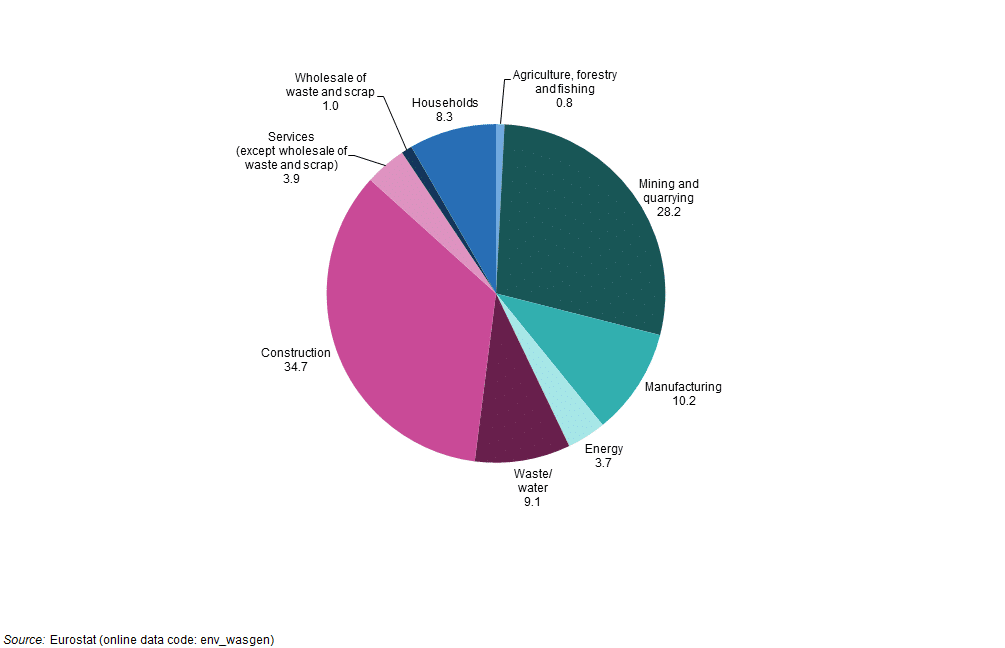
Carbon emissions
The construction industry is, unfortunately, a champion when it comes to greenhouse gases emissions. The equipment used on sites is the primary source for such emissions. Only in the UK, the building industry is producing 47% of all the nation’s CO2 emissions. And that’s not all:
“Our industry is the one that consumes most of the planet’s resources. When it comes to carbon, we are 40% of everything that is emitted to our world. ” – Stefan Larsson, CEO of BIMobject

These numbers indicate that the problem is real and it will just grow bigger unless we learn to protect and use our data. The smarter use of the equipment will eventually lead to fewer emissions and a greener construction.
Safety concerns
It’s no secret that working in construction can be tremendously dangerous. Based on the data of the ILO – International Labour Organization, one out of five deadly workplace injuries are occurring in construction. Ulrik Branner, GenieBelt CEO, referred to this vital issue on his recent talk in the Unlimited Future X Forum:
“Every armed conflict in the world together has less victims than the construction industry on a yearly basis!”
It doesn’t take much to realise that construction is on a crucial path and that it is time for everybody in the industry to act and search for viable solutions. Digital data can be the answer, as solid planning can eventually transform construction to a safer place with fewer fatal miscalculations.
Data is the new oil and here’s the proof
By now, it’s apparent that the construction industry is in a very difficult position and that there is a strong need for accountability and transparency. Data is the medium that will bring this coveted change. A few months ago, The Economist published a great article about the importance of data. It characterised data as the most valuable resource of the planet, the new oil.
[clickToTweet tweet=”Data can offer great power to those who will be smart enough to control its flow!” quote=”Data can offer great power to those who will be smart enough to control its flow!”]
This new lucrative commodity can offer great power to those who will be smart enough to focus their efforts on controlling its flow. In short, these are the main reasons why data is a true game-changer both for construction and for every other industry out there:
Quantity is also quality
Many people associate vast amounts of data with chaos and loss of scope. But that is a very wrong approach. Quantitative data can provide remarkable insights, if read in the right way. Especially in today’s world where digital tools (eg. smartphones) are an integral part of our daily life. In that sense, it becomes extremely easy for the leading players of every sector to follow the digital trace of the users and adjust their message, product or processes according to their needs.

Source: Claude AI
This new reality can help construction to evolve in many ways. Firstly, data could help a lot with mapping the behavior of construction agents both on site and office and acquire a better understanding of the problems that they come across on a daily basis. The implementation of Artificial-Intelligence techniques (eg. machine learning) can be another benefit that big data could offer. Well-elaborated algorithms could predict potential risks in the construction process. Furthermore, it could detect new promising clients and markets for construction. Companies that will invest in such technologies can easily turn themselves into drivers of change.
Internet of Things (IoT)
One of the biggest challenges for the construction industry and its future has to do with the need to get all the available information unified. This interconnectivity will establish efficient and trustful communication channels between the numerous project agents. In other words, it will empower the flow of information and contribute to the modernisation of the whole sector.

IoT can transform the way we used to build. Especially when we are talking about more perplexed building structures, it can simplify things and help the project team to take control over the project. Real-time data can also allow for immediate action and improved decision-making which will eventually prevent many costly mistakes and delays.
In a few words, here are some of the many distinct ways that IoT can help construction:
- Building maintenance
- Asset management
- Construction telematics
- Safety in construction
- Fleet management
Competition changes
Massive quantities of data can transform the way the firms in the industry compete. That makes total sense if you consider that the whole nature of the game changes. One of the main priorities in the endeavor to conquer the market should be the investment in network effects. The more people you get to use your platform the easier it becomes to expand your business. This concept applies to every industry and construction could be no exception. The positive side, in this case, is that the immense collection of data provides the opportunity for a more direct feedback from your clients which leads to a better understanding of their needs.
Want to learn more? This is the key to unlocking efficiency in construction
In that sense, big data can function as a safety net that allows you to gather knowledge and improve your platform, or the construction process as a whole for example. To put it differently, data offers a “God’s eye view” on everything that is taking place on the market. This can protect you from unpleasant situations either we are talking about the building market or the building process per se.
The car industry shows the way for construction
The car industry is a very interesting example of the power that data holds. This could certainly be a good wake-up call for construction, too. During the 90’s, the European and US car industry was under extreme pressure as a result of the emergence of the Japanese in the market. The main reasons were high production costs and low investment in innovation. The advent of new technologies helped the industry a lot to get out of this dead-end.
For that reason, the European and US agents decided to follow the steps below:
- They opened up and reorganised the value chain
- Supported a culture of openness and collaboration within the industry
- Invested in IT and introduced systems that ensured data sharing between the different companies (ERP systems)
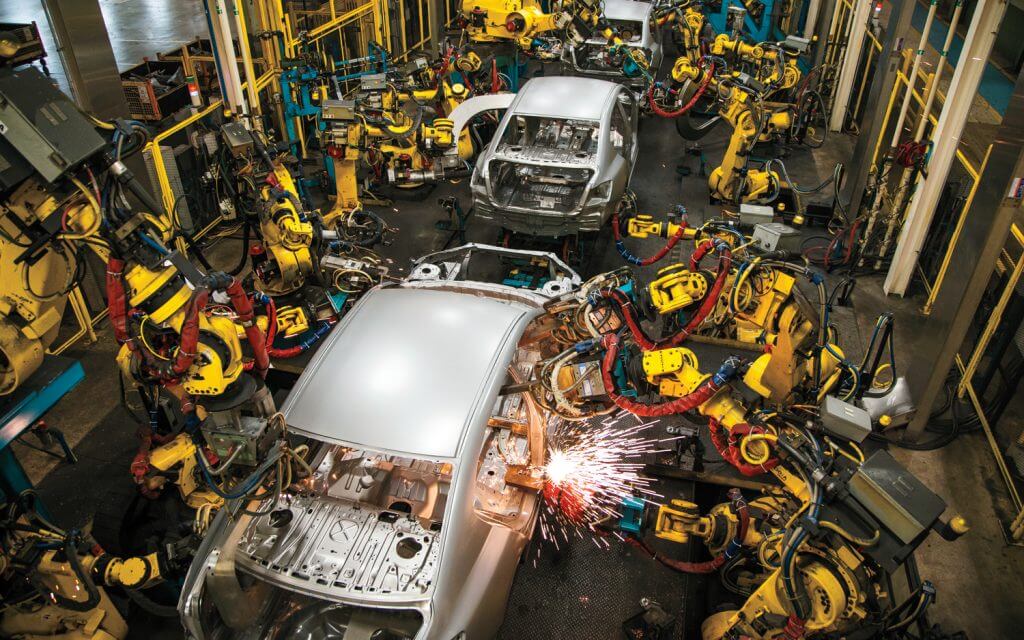
These indispensable changes led to a brighter future for the car industry and more analytically to the following:
- 3% cost reduction (BCG report, 2004)
- Many vendors to the industry disappeared, but the main suppliers became much bigger, more profitable by being “System Vendors” that ensure crucial innovation and high profitability via close collaboration with the car manufacturers.
- The automotive industry invested more in IT and innovation.
- Much closer cooperation with key suppliers was introduced. This included sharing of data, systems and employees.
Thanks in parts to these steps, the European and US car manufacturers became ultimately stronger and today they appear to be equals with the Japanese manufacturers. It goes without saying, then, that innovation and heavy investment in digitisation are the best solution for construction, as well.
Connecting the dots in the construction industry
During his recent keynote speech, BIMobject CEO, Stefan Larsson mentioned that construction needs to connect the dots and focus on deploying the information faster and more efficiently .
We couldn’t agree more with him. It is time for the industry to open up and embrace innovation and open collaboration. Only then, we can allow to the fundamental components of the construction process (builders, subcontractors, superintendents etc.) to deliver their best work in the most efficient way.
It is, unfortunately, no exaggeration to claim that construction has seen very little innovation in the course of the last decades. As stated by McKinsey Global Institute, construction scores very poorly both in digitisation and productivity growth. To the contrary, sectors such as ICT and media are leading the race.
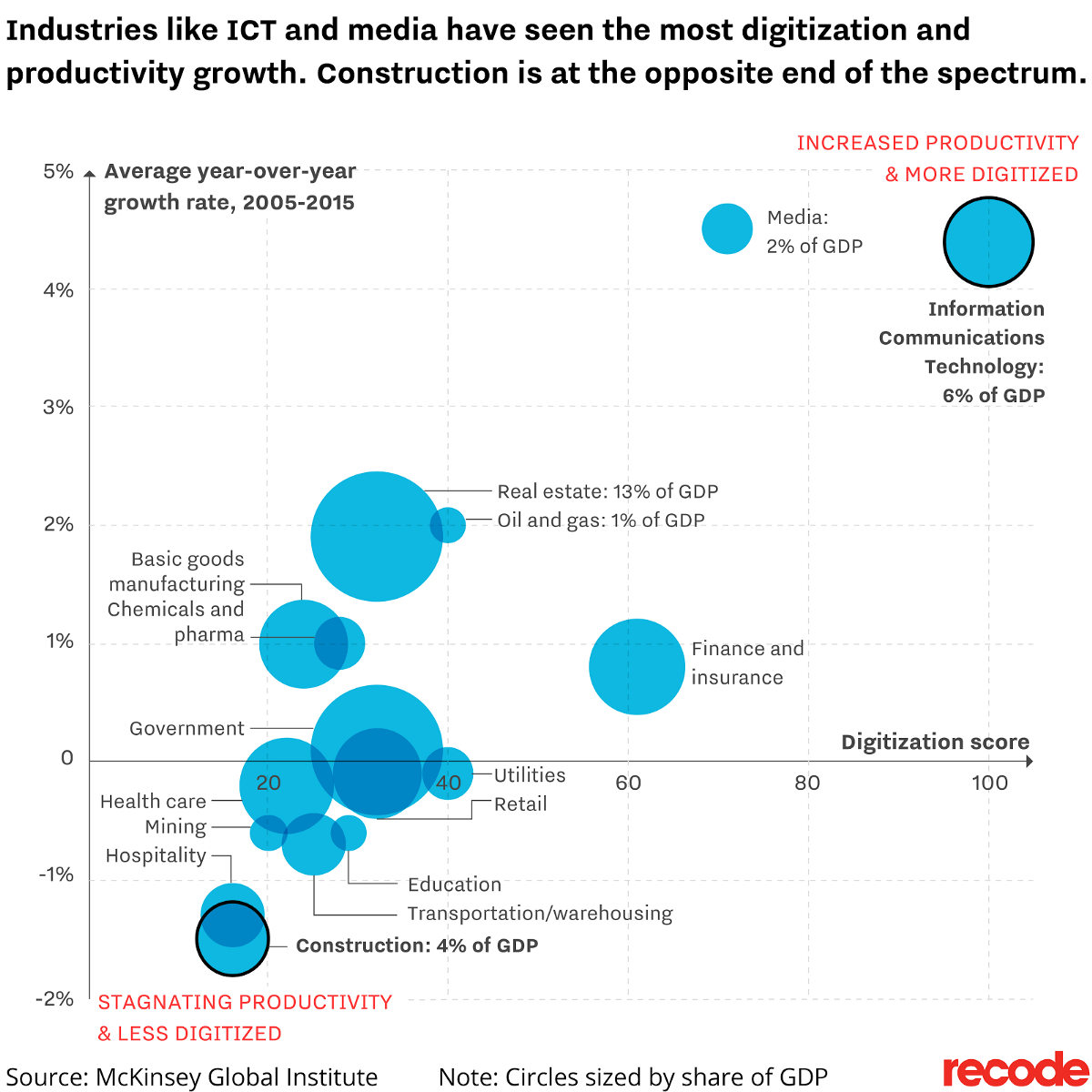
It doesn’t take much to realise, then, that the industry is in an immediate need for change. Who are the main drivers who can bring a new era for construction? Simply put, everybody actively involved in the building sector. From governments to construction firms and clients. Especially for clients, we believe that they can play a significant role in this strategic shift. They are the ones who should push contractors to invest in digital technologies. However, they are only a part of the whole endeavor.
Ulrik Branner, GenieBelt CEO, highlighted in his recent interview at ConstructionNews that a coordinated effort by all the various parties is required:
“Now is the time for everyone in the industry to take the stand and be on the side of transparency and accountability and mandate this throughout their projects.”.
In that way, the industry can build a more sustainable future. By gaining access to the right information, safer conclusions can be made. The establishment of a more inclusive and collaborative sector will lead to a more efficient future for every single aspect of the project lifecycle. Starting from design and materials to operating conditions and powerful real-time communication between the site and the office.
[clickToTweet tweet=”Construction is a $10 trillion giant with feet of clay!” quote=”Construction is a $10 trillion giant with feet of clay!”]
Synopsis
The earlier we manage to unlock the construction process and start keeping proper track of our data the easier it will be to bring all the agents together in a well-integrated environment and help the industry recover. In any other case, construction will remain a $10 trillion giant with feet of clay.
